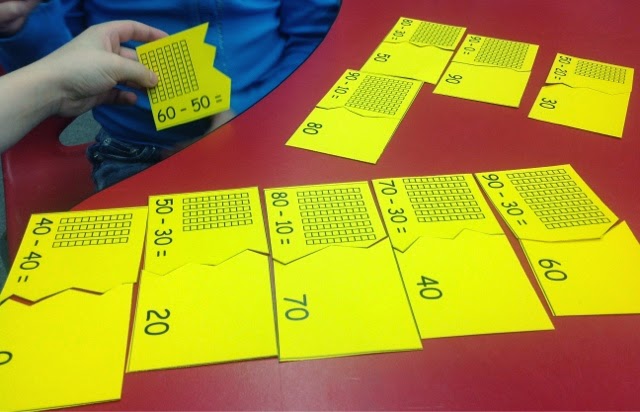CCSS.MATH.CONTENT.1.NBT.C.6
Subtract multiples of 10 in the range 10-90 from multiples of 10 in the range 10-90 (positive or zero differences), using concrete models or drawings and strategies based on place value, properties of operations, and/or the relationship between addition and subtraction; relate the strategy to a written method and explain the reasoning used.
When working on this idea of subtracting multiples of 10, I am always struck by how easy it is for some kids and how much other kids struggle with this concept. Many of my students see doing a problem like 90 -50 as a natural extension of doing a problem like 9 - 5, but others need more support. Here are some ways we address this standard.
I start out at a very concrete stage by using my magnetic base 10 pieces
I also do a whole group lesson where each kid has access to unifix cubes
 |
| A student uses unifix cubes to show 90 - 40 |
After this, I introduce a game that will be played during math stations the following week. It is a math puzzle game and is super engaging to students. I also really like how it has a visual model so support kids who still need it. As they play it throughout the week, I notice less and less students needing the visual model, but at the beginning of the week, many kids use it.
 |
| A student uses her hand to check her answer to 80 - 30. The puzzles are self-checking! If a student gets the wrong answer, the puzzle will not fit together. |
 |
| A pair of students finishes up the subtracting multiples of 10 puzzles. |
 |
| This formative assessment is a great way to asses students current understanding and see who needs more instruction or intervention. It is part of the grade 1 number puzzle bundle. |
Based on the results of this formative assessment, I had 3 kids who needed more instruction. I borrowed an idea from my blogging buddy Linda over at Primary Inspiration and used legos to represent base 10 pieces. While the other kids were busy with math stations, I pulled these three kids to the back table and we worked on more problems and explicitly tried to make the connection between what they already knew and what they were learning now.
to represent base 10 pieces. While the other kids were busy with math stations, I pulled these three kids to the back table and we worked on more problems and explicitly tried to make the connection between what they already knew and what they were learning now.
I will check in with these 3 kids again next week but I think they got it now!
How do you address subtracting multiples of 10 with your students? Please respond in the comments below!
How do you address subtracting multiples of 10 with your students? Please respond in the comments below!







Nice! I really like the cards. I have a similar product with my bags of oranges cards (in relation to my place value book). Hopefully it comes in handy with those visual learners. Here is a freebie with some of the cards--not sure if you saw it.
ReplyDeleteThanks again for doing a guest post (it's had 1080 views).
~Lucy
Kids Math Teacher
Love your place value book!
DeleteI do it the same way you explained. I start with a whole class mini lesson where I am the only one with the manipulatives. (on the document camera) Then I give pairs of students linker cube and have them build 5 groups of ten. After that I write equations on the board and the children solve them. Finally I hand out ipads to pairs and they solve the problems using the app. number pieces. By that time, most of the kids are ready to move to the more abstract, paper and pencil.
ReplyDeleteThanks for sharing. Julie
heyjbales@sbcglobal.net
Hi Julie! Looks like we share similar ideas about teaching this concept! It shouldn't be to challenging for kids if they have a good foundation in facts and place value.
Delete